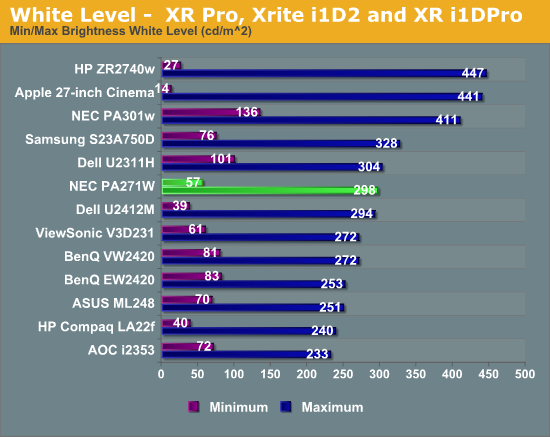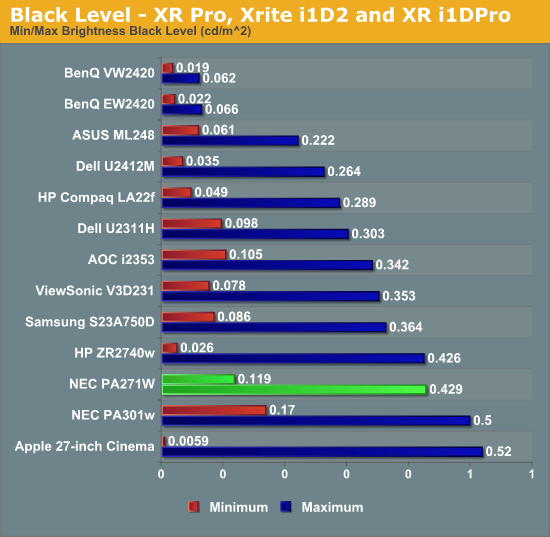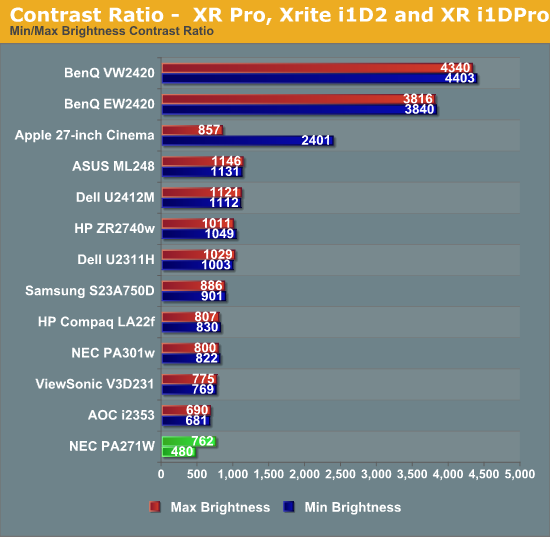NEC PA271W - When Accuracy and Consistency Matter
by Chris Heinonen on May 1, 2012 1:55 PM ESTNEC PA271W - Brightness and Contrast
The NEC is rated fairly conservatively at only 300 nits of light output at maximum, though for a professional work environment that is likely more than anyone would need. The OSD for the NEC lets you know the light output in cd/m^2 (which is equivalent to nits) as you raise and lower the value, and once you move past 250, the color changes to let you know you’re going beyond where the screen uniformity measurements can help you. Driven to the maximum output, the screen might read 400 cd/m^2 but the actual value was far less than that.

As we can see, we managed right around the maximum value of 300 nits, so that conservative estimate is right on in this case. The OSD might not indicate the correct value once you move past the recommended 250 cd/m^2 level, but below that it seemed to be within 3-4% of the listed value which was pretty good. You can see the lowest light output level was down to 57 nits, which means you can adjust the display to be dim enough for any work environment you might have.
Of course, with our accurate white levels we have to hope that we get good black levels as well, which has not been the high point for IPS screens with CCFL backlights, as opposed to LED dimming setups, in the past.

Unfortunately our black levels do leave a bit to be desired. The level at the minimum is 0.119, and I’d hope for something closer to 0.050 or less, and the maximum level was 0.429, which looks closer to a dark gray than black at that level. These indicate that our contrast ratio probably is going to leave a bit to be desired with the NEC.

As we could guess, the contrast ratio with the minimum backlight is only 480:1, and it rises up to 762:1 with the monitor at maximum output. With the wide swing between these two values I went ahead and measured the contrast ratio at our calibrated 200 nits setting and found it was 561:1, so the ratio improves as the light output level increases. It seems there is a minimum amount of light that the IPS panel is going to let through, which could be related to the screen uniformity technology used by NEC on the display, but you should be aware that if you want deep, dark blacks you’ll need to look for a different display using either a different panel technology, a different backlighting technology, or both.










69 Comments
View All Comments
Oxford Guy - Wednesday, May 2, 2012 - link
I have three bones to pick:1. The sRGB color space is important, more important than AdobeRGB for most users, and yet Anandtech's monitor reviews always fail to provide information about sRGB coverage and use AdobeRGB as the baseline for comparison.
2. The chart heading calling monitor gamut "color quality" is misleading, especially when dealing with wide-gamut monitors that have non-functioning sRGB modes -- leading to overly saturated color when viewing sRGB content. For many users, such a monitor would be considered to have inferior color "quality". Also, for sRGB content, a standard gamut monitor with good uniformity and good black level would have good "color quality" when used with sRGB content—potentially better than a wide-gamut monitor with poor black level. Change it to "color range", "gamut", or something else that doesn't give the impression that the colors the monitor is capable of representing are somehow better simply because there are more of them.
3. There is still no mention of PWM flicker in the article, or whether or not this model uses PWM or constant control.
Oxford Guy - Wednesday, May 2, 2012 - link
The other problem with "color quality" as a heading is that it doesn't reflect banding, noise, and other issues related to FRC dithering, the lack of a hardware LUT, broken hardware firmware (as was documented in the Dell U2410 by prad.de -- user mode wasn't working properly), and such.bjnicholls - Wednesday, November 28, 2012 - link
sRGB is a small subset of ARGB. Any wide gamut display used with proper color managed workflow can accurately display the thin, weak color gruel that is sRGB.sRGB is the "least common denominator" color space and the only thing important about it is knowing how to deliver images optimized for sRGB with as few negative effects as possible.
beebbeeb - Wednesday, May 2, 2012 - link
A review of any "professional" grade monitor would not be complete without benching it against the gold standard : Eizo. On reviewing Anandtech archive the last review of an Eizo was in 2006, a shootout involving Eizo L997, which duly came out as the champ. On the strength of that review, I bought one for nearly US$2,000 in 2006, used for viewing CAD drawings. Look forward to a "hottubbing" of the NEC, Eizo and other professional monitors.appliance5000 - Wednesday, January 2, 2013 - link
I think NEC is as much a gold standard as Eizo - has that ever been a question.UrQuan3 - Thursday, May 3, 2012 - link
You know, the funny thing is I *HATE* dimming backlights. It's like a car that adjusts the volume based on how fast you're going. I'm sure it makes benchmarks give better numbers, but it's really unplesant to use.The backlight on my laptop changes based on how much white there is on the screen. The effect is that everytime I open a menu, all the colors on the screen change. It's implemented in the Sandybridge drivers and cannot be turned off. The only way to prevent it is to run the screen at full brightness. That seems to disable the dimming.
seapeople - Saturday, May 5, 2012 - link
FWIW, I hate it when cars DON'T have auto volume based on the speed you're going. What sounds appropriate at 70 on the highway is absolutely blasting when you come to a stop. Don't understand what you'd have against it.bobbozzo - Monday, May 7, 2012 - link
Yeah, the 'dynamic contrast' on my Samsung 2343BWX is unbearable for PC work. Fortunately it is easy to turn off.mtfreitasf - Thursday, May 3, 2012 - link
I have been following your monitor reviews for a while but have never heard about Eizo which has a name in the pro market. Is there an explanation for this omission? Yours.